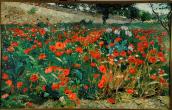Jean and Graham Devoe Williford Charitable TrustFairfield, Texas |
|
About Graham Williford |
|
The Willifords originally settled in Fairfield, Texas in the late 1800s. For those of you that have been through Fairfield, you may remember the ďbig white houseĒ behind Dairy Queen. That was the original home of Grahamís family. In its prime when you looked out the front door all you saw was farmland; now it is lined with fast food restaurants along Highway 84 and businesses along Highway 45. The house was recently demolished but there are many articles regarding its stature and beauty online. The Willifords believed in education. Grahamís great-grandfather made sure all his children, including both his daughters, which was unheard of at the time, received college educations. Grahamís mother was a teacher and his father a landowner and entrepreneur. They stressed education and Grahamís mother encouraged each and every one of her children to follow their dreams. Grahamís brother became a surgeon, established his practiced in Mexia, and was well known and well liked in the community. His sister, Harriette, followed in her fatherís footsteps, went into the insurance business, and was one of the first Republican political leaders in Freestone County. Graham followed his dreams and eventually became a world renown art collector. When Graham graduated from Fairfield High School in 1943 he made his way in the world far away from Freestone County. It is safe to say that few knew how influential he would became in the world of art and to what extent his expertise would be sought by inhabitants of that exclusive world. He was born on February 22, 1926 and raised in Fairfield. Mr. Williford served in the Navy after graduation during World War II. After the war ended, he received a Bachelor of Arts degree in Art History from Columbia University in New York City where he made his home. Following graduate studies at Columbia, Mr. Williford made his way to Paris, France, where he practiced to become a concert pianist at a music conservatory there. He became intensely interested in American art during his stay there, and later made his second home at a Paris apartment. His father, thinking that his son was in need of guidance, encouraged Graham to return to Fairfield and become a rancher. He even added an apartment to their family home so Graham would always have a place to come. He had no idea the magnitude of Grahamís talent and eye for art. The 2005 exhibit, There and Back Again, investigated the ways in which American art later struggled to create its own traditions, away from the looming influence of the Old World. "Graham Williford had a distinctive and highly refined taste for fine art objects" says Dr. William Rudolph, former curator of The Dallas Museum of Art. He also had a taste far in advance of his moment. When museums and galleries only concentrated on nationalistic subject matters, Mr. Williford daringly explored the international exchange between America and Europe. ďFortunately for us, this selection from his collection allows us to investigate the important and richly textured history of American artists and designers working, exhibiting and studying abroad in the critical final decade of the 19th century,Ē Dr. Rudolph says. "The works assembled represent one of the most distinctive private collections of its kind," he adds. Mr. Willifordís collection consisted of more than 1100 works and includes major silver pieces by Tiffany and Gorham, with a substantial range of rare flatware and pieces previously owned by William Vanderbilt. The selection includes silver in the Japanese taste inspired by the displays of Japanese art at the renowned Paris Exposition of 1867; as well as works emphasizing the later movement toward naturalism, with pieces such as Tiffany & Co.ís Hopi vase, suggesting the design of a period Native American vessel. "The richness of Mr. Willifordís silver holdings marks the unparalleled achievement of the American silver industry in the last decades of the 19th century," says Kevin W. Tucker, curator of decorative art of the Dallas Museum of Art. Also on view in the exhibition were both well-known and less celebrated silver pieces by Tiffany & Co., Gorham, and George W. Schiebler & Co., along with paintings by artists such as Thomas Wilbur Dewing and Elihu Vedder. According to Mr. Tucker, "They reveal a collector of prescient vision and dedicated connoisseurship. Described by the Dallas Museum of Art as a "longtime supporter," Mr. Williford still has other paintings and silver works on view in the museumís permanent collection galleries, including several works in the new American Silver Gallery. He left a legacy for the enjoyment of the masses that is now enjoyed around the world. The DMA Exhibition ďThere and Back AgainĒ showcased rare and little-known examples of early 19th-century American painting and silver pieces, studying the search for a national artistic identity through "American" styles and subjects back home. It included more than three (3) dozen important American pieces created by artists who were studying, working and exhibiting in Europe and America within the critical era of the 18th and 19th century. The Graham and Jean Devoe Williford Charitable Trust was formed upon Grahamís death. It was his wish that what he had spent so much time collecting would be made available to the public for their education and enjoyment. It is our mission to see his dream come true. The Foundation has its offices in Fairfield, Texas and houses a small collection of Grahamís works at all times and is open to the public. The Foundation has pieces on loan at the Amon Carter Museum, High Museum in Atlanta, Georgia, as well as the Dallas Museum of Art. The Grace Museum will soon be exhibiting the ďMediterranea ExhibitĒ, a 71 piece collection of some of Grahamís works which has also been at the University of Oklahoma Fred Jonesí Museum and the Art Museum of Southeast Texas in Corpus Christi. The Tyler Museum of Art has had several significant exhibits of the Graham Williford collection and currently houses the majority of Grahamís collection. The Foundation has two trustees, John R. Williford, Grahamís cousin, of Austin, Texas and Thomas C. Campbell of Dallas, Texas, who oversees the administration of the Foundation and ensures that Grahamís dream stays alive. Graham was best known for his dog, his hats and his Texas British accent but he always had a joke and a smile. He loved Fairfield and he always believed in supporting this community. He donated many fine pieces of furniture and art to the Moody Bradley House in Fairfield, Texas and we also support the newly formed Trinity Star Arts Council in Fairfield, Texas. As the years have gone by I feel I have come to know Graham more and more through his art and the love he had for art and, more importantly, for the artists that created the paintings. There was a reason for every piece of art Graham collected and only Graham knew those reasons. Unfortunately, he kept that knowledge in his head and a lot was lost when he died. I will best remember that Graham was a soul misplaced in time. He belonged in the era with the great families such as the Vanderbilts, Carnegies and Rockefellers. He was a great man with a great heart and is missed by many. |

